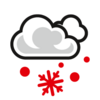An increasing number of people enjoy walking with measured steps through the snow and rediscovering nature far away from the ski slopes. Many tourist regions offer both marked winter hiking trails and signposted snowshoe routes. Whether winter hiking or snowshoeing: as with “normal” hiking in summer, tours in the snow require thorough preparation and careful planning.
Winter hiking the correct way
For winter hiking, you can follow the signposted winter hiking trails (pink signposts with a hiker symbol). They are preferably routed away from roads and are usually on snowcovered terrain. Winter hiking trails require a special degree of alertness and caution because of the snow and the risk of slipping. Apart from that, they do not pose any exceptional demands on hikers and correspond with the technical requirements of a yellow-marked hiking trail without obstacles.
Surefooted through the snow
If you have little experience with snowshoe trekking, it is best to follow the signposted snowshoe routes (pink signposts with a snowshoe symbol). These are protected against avalanches and difficult passages are usually secured. However, they are not nearly as well groomed as the winter hiking trails and are therefore only suitable for snowshoes, not hiking boots. If you are planning more challenging tours away from the marked routes, you should be sure to assess your technical ability and physical fitness accurately. The more experienced you are, the better you are able to assess potential dangers. This applies especially to the risk of avalanche. According to the Swiss Council for Accident Prevention (BfU), the majority of serious accidents that occur while snowshoe trekking are a result of avalanches. Therefore, when snowshoeing, always take into account the current snow conditions. Consult the avalanche bulletin to find out about the avalanche situation, and ask the mountain transport staff again on site about the local conditions.
Continually reassess the situation
An experienced snowshoe trekker will also constantly reassess the situation throughout the tour and, depending on the time of day, take account of rising temperatures. You can reduce the risk of being caught in and buried under an avalanche by taking various measures. These include having good knowledge of the terrain and reacting to potential dangers accordingly. When embarking on a tour in the snow, you should always carry with you a standard emergency kit, comprising an avalanche transceiver (LVS), an avalanche probe and a compact shovel (see also: www.rega.ch/avalanches).
Suitable clothing and shoes
As with normal hiking, winter hikers and snowshoe trekkers also need to make sure they are wearing appropriate clothing. Sturdy, waterproof shoes with profiled soles keep your feet dry, support them and give you a better grip. In addition, good footwear helps prevent you from slipping or stumbling. Your clothing should suit the prevailing weather conditions and also include protection against the rain. Be sure to take with you analogue or digital maps (e.g. hiking map or a hiking app that can also be used without mobile phone reception) and sufficient provisions. Your equipment should also include a first-aid kit, a survival blanket and a mobile phone. It is advisable to make sure your mobile phone is fully charged before you set out and then to keep it warm and protected.
Calling out Rega
Despite extensive planning and taking sufficient care in mountainous terrain, accidents or medical problems can still occur. In such cases, do not hesitate to alert Rega via the Rega app or the emergency number 1414. In an emergency, it is vital not to waste any time: bad weather, darkness or poor visibility can delay a rescue or even make it impossible. Do not wait too long.








